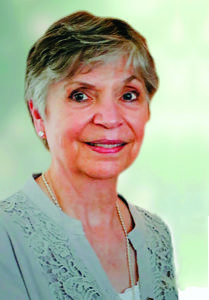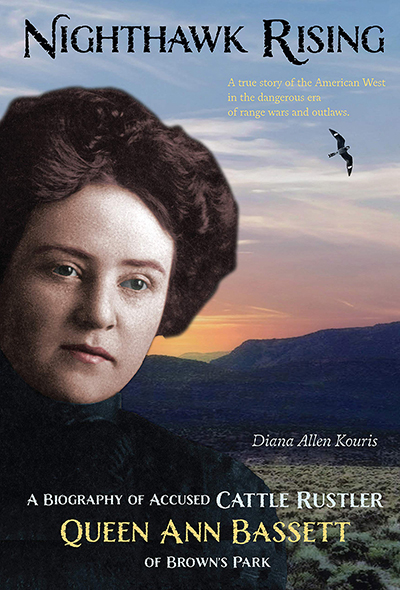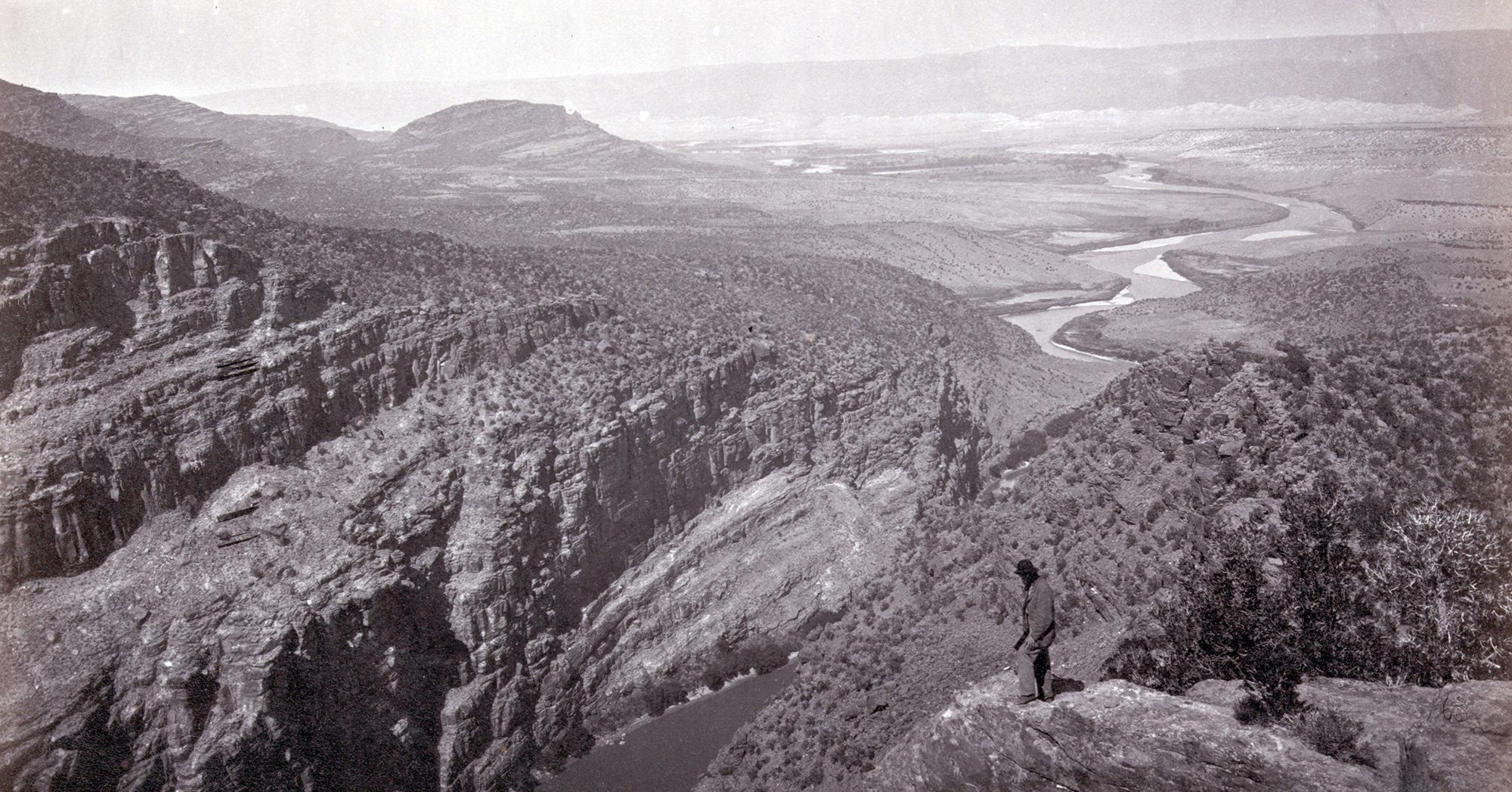 An old adage counsels, “Write what you know.” Well, Diana Kouris certainly knows the history of Brown’s Park, Colorado, and she relates an intimate story of the valley in Nighthawk Rising: A Biography of Accused Cattle Rustler Queen Ann Bassett of Brown’s Park. Bassett and Kouris’ grandmother were friends, and Kouris grew up on a ranch adjoining the Bassett ranch. She rode the same trails Ann had decades earlier, and she listened to the stories passed down by Brown’s Park families. Moving beyond the legend, Kouris painstakingly dug into the archives, gleaned details long buried within existing documents and unearthed new sources. Nighthawk Rising reads like a novel, but every story in it is verifiable history. Western Writers of America honored Kouris with its 2020 Spur Award for best biography. The High Plains Book Awards and Colorado Book Awards have also recognized the book. Kouris also wrote The Romantic and Notorious History of Brown’s Park and Riding the Edge of an Era: Growing Up Cowboy on the Outlaw Trail.
An old adage counsels, “Write what you know.” Well, Diana Kouris certainly knows the history of Brown’s Park, Colorado, and she relates an intimate story of the valley in Nighthawk Rising: A Biography of Accused Cattle Rustler Queen Ann Bassett of Brown’s Park. Bassett and Kouris’ grandmother were friends, and Kouris grew up on a ranch adjoining the Bassett ranch. She rode the same trails Ann had decades earlier, and she listened to the stories passed down by Brown’s Park families. Moving beyond the legend, Kouris painstakingly dug into the archives, gleaned details long buried within existing documents and unearthed new sources. Nighthawk Rising reads like a novel, but every story in it is verifiable history. Western Writers of America honored Kouris with its 2020 Spur Award for best biography. The High Plains Book Awards and Colorado Book Awards have also recognized the book. Kouris also wrote The Romantic and Notorious History of Brown’s Park and Riding the Edge of an Era: Growing Up Cowboy on the Outlaw Trail.
What inspired you to write about Bassett?
I knew that so much written about Bassett was not based in fact and didn’t resemble the “Queen Ann” who became my grandmother’s friend when both women were in their 20s. The decades of parodies of Ann did not mesh with the complex and gracious cattlewoman my elderly uncle said he loved and admired from the time he first saw her when he was 5 years old. I stood in front of my writing desk one morning, looking at historical photos of Brown’s Park, when from another place and time Bassett’s whispers compelled me to write her story. I deeply recognized the moment had come for me to devote all I could muster into seeking her truth and writing it as a work of merit.
‘I had a unique perspective while writing this book, not only because of a family connection with Bassett but also because I grew up absorbing the enchantment of her valley’
How did you sift through the fiction of her storied life?
I have always found it an awesome responsibility to write about the lives of those who came before. Throughout the process of researching and writing Nighthawk Rising I felt an obsessive determination to write Ann’s biography with depth and truth. My research was exhaustive, and my documentation meticulous. I in a sense time-traveled into the era of range war and outlaws, where I joined Bassett and the other history-makers who embroidered the fabric of Ann’s life. I came to know them well, as I ignored old interpretations and relied on research gleaned from a mountain of firsthand accounts and trustworthy documents.
What were some of your primary sources?
Firsthand accounts came from a multitude of sources. A sampling of those: Sam Bassett’s letter to J.M. Blansit about the murder of Mat Rash; Joe Davenport’s moving and detailed depiction of Isam Dart as he knew hi; Jesse “Jess” Taylor’s interview that explains his relationship with and insight into the Bassett family and the nightmare that haunted Ann’s brother, Eb; Minnie Crouse Rasmussen’s interview account of the events surrounding the suspicious death of Ann’s sister Josie’s fourth husband; Norma Gardner Snow tells her memories of the aging Queen Ann and Ann’s nearly instantaneous transformation from an older lady of refinement to a cowgirl on horseback expertly roping and handling a wild cow; a collection of Ann Bassett’s personal letters; and unpublished writings that convey Ann’s character and provide significant particulars, including evidence of the validity and author of “Confidentially Told.”
Among the documents I used were “The State of Colorado, Plaintiff v. Anna Bernard and Thomas Yarberry,” which provides information surrounding Ann’s arrest and trials for cattle rustling; “H.H. Bernard, Plaintiff v. Anna Bernard, Defendant,” which concerns Ann’s divorce and gives revealing details about the couple; “Affidavit of Charged Offense Filed by Thomas Horn Against Isam Dart,” which places Tom Horn at the center of the killings of Isam Dart and Mat Rash; “Estate of Isham Dart Affidavit,” which lists the modest possessions of a supposed prolific rustler; “Inquest Hearing of Elbert Bassett,” which paints a chilling and detailed picture of suicide; “Testimony in Relation to the Ute Indian Outbreak, House of Representatives, 46th Congress, 2nd Session, No. 38, May 1, 1880”; and “Copy of Evidence Taken Before White River Ute Commission, House of Representatives, 46th Congress, 2nd Session, No. 83, May 14, 1880,” which enabled me to write the events of the Meeker Massacre with gripping realism.
 What makes your book unique?
What makes your book unique?
I believe there is a factual history to be uncovered and told as well as an emotional history to be brought forward. I had a unique perspective while writing this book, not only because of a family connection with Bassett but also because I grew up absorbing the enchantment of her valley, Brown’s Park. I was from birth enfolded in the valley’s history as it encircled me and my cattle ranching family. I therefore wrote many details from personal knowledge. This book is filled with rare photographs and a trove of new material and unique details, such as how she came to be called “Queen Ann.” It lays out the truth of the men Isam Dart and Mat Rash, long maligned and written about as common cattle rustlers. Another unique element is the revelation of Bassett’s never before published handwritten menu and full description of the 1893 “Wild Bunch Dinner” (aka “Outlaw Thanksgiving”). I also discovered new findings to clear up and thoroughly explain events surrounding some of the incidents found in Ann’s published memoir, including the killing of Jack Rollas and the Ute skirmish that caused Ann and her best friend to make a frightful ride for home in the dark.
What other stories do you tell of the region?
Nighthawk Rising enters the throes of the Meeker Massacre to tell the harrowing accounts of three white women taken captive by the Utes. I researched hundreds of pages of interviews and of their direct testimony in government hearing documents to unveil for the first time vivid and profound details of the ordeal through their eyes and precise words. The book also gives a powerful voice to the Ute people, bringing to light the direct testimony of some of those involved in the complicated and drawn-out event. I uncovered the fascinating backstory of Chief Ouray’s sister, Susan (Shawsheen), who valiantly intervened on behalf of the captives.
How is she tied to the Wild Bunch?
A few of the young men destined be part of the gang that came to be known as the Wild Bunch were well known to Ann and the Brown’s Park community. When they were teenagers and before they were wanted by the law, the young men worked in Brown’s Park as ranch hands. Elzy Lay was hired on by Ann’s parents and lived at the Bassett Ranch for about a year. Butch Cassidy worked for the Brown’s Park Livestock Ranch (the ranch where I grew up). The young men were included in social events, and all the young people became friends. According to Ann, the Sundance Kid was present along with Cassidy and Lay during the Thanksgiving celebration she called the “Wild Bunch Dinner.”
As time passed, both Cassidy and his partner and close friend Lay occasionally stopped by the Bassett Ranch to sit with the family for a meal and have a brief visit. Although their friendship with Ann remained, neither Ann nor her older sister, Josie, were ever romantically involved with them and played no part in Butch and Elzy’s infamous activities and life of crime.
‘Although our ages were seven decades apart, we rode the same trails, admired the stately mountains surrounding us as we formed a selfish love for our valley home’
Her connections to Dart, Rash and Tom Horn?
Throughout Ann’s journey to adulthood her valley became a magnet to men of all sorts. Most held a gut desire to make a living out of cowboying and ranching. Foremost in that group was Rash, with whom Ann fell in love, and also Dart, a tall and talented top hand cowboy. Both men were ever loyal to the Bassett family and were highly regarded in Brown’s Park. However, they rode in a tumultuous time when complex truths and falsehoods blended to form a toxic brew on the rangeland and in the courts, pitting cattle barons against small ranchers. By 1900 Rash was Bassett’s fiancé, president of the Brown’s Park Cattle Association and the most prominent rancher in the valley. Nonetheless, both he and Dart were riding along the edge of their lives. The insidious tendrils of a range war had delivered into their midst the outlaw hunter, stock detective and hired assassin Tom Horn. Horn infiltrated Bassett’s world, killed Mat and Isam, and shattered the young cowgirl’s life.
In what ways was Mat Rash’s death a major turning point in Ann’s life?
The death of Mat Rash severely and irrevocably changed the course of Ann’s life. The tragedy not only sparked the beginning of her vendetta against cattle baron Ora Haley, who had hired Horn, but also set the course for her journey into legend.
How did Ann’s family influence her?
Ann’s mother, Mary Eliza “Elizabeth” Bassett, rode sidesaddle beautifully, was the center of the Bassett family, exuded strength of character and independence, and was the undisputed commander of the Bassett Ranch. Elizabeth was the most powerful force in Ann’s young life.
Deeply religious, scholarly and tenderhearted Amos Herbert “Herb” Bassett, Ann’s father, was a musician and developed musical talents in all his children. Herb’s inclination to rule by love alone was no match for Ann’s rebellious nature.
Ann’s older brother, Sam, an earnest young cowhand, witnessed his little sister’s desire and potential to be a top hand. He espoused a philosophy that came to form the bedrock of Ann Bassett: “If you are going to be a full-fledged cowpuncher you must play the game square, take it on the button, and never shy at rope burn or pistol smoke.”
What of Ann’s sister, Josie?
Josie, Ann’s older sister, lived an interesting life, but it was very different from Ann’s. While Ann and her sister loved each other without question, they often found it difficult to be in close proximity. Because Josie was the oldest child in the family, she took the lead with household chores and child care. Ann, five years younger, never did. Instead, her privileged spirit ran free when she was turned loose on the ranch. Although both girls had independent personalities, Josie, heavily freckled with light copper hair, was more serious; Ann, who was lightly freckled and had darker hair, was tenacious and at times dreamily poetic. The sisters often clashed.
Josie married young and repeatedly. Supposedly the steady and serious-minded one of the Bassett girls, Josie was multifaceted in her personality and had obvious complications and struggles left unhealed. She was whispered to be a murderess and a thief when she married her fifth husband shortly after the death of her fourth.
How difficult was the book to research?
This book required a tremendous amount of research and an exhaustive effort to gather, sort, organize, absorb, write and document. The sheer volume of research was beyond daunting, as was the challenge to transform it into a manuscript worthy of becoming a book of historical significance.
Anything too elusive to track down?
I longed to find photos of Ann’s mother, Elizabeth, and brother, Sam, but to no avail.
In what ways does your own background compare/contrast with Ann’s?
Bassett and I both received the providence of being the daughters of Brown’s Park cattle ranchers. My family’s ranch house sat just across the Green River from the meadow on Willow Creek where Ann was born. Although our ages were seven decades apart, we rode the same trails, admired the stately mountains surrounding us as we formed a selfish love for our valley home, and we breathed the same ancient fragrances when we worked cattle on the range. At dusk, after long days in the saddle, we were both escorted home by the grace of nighthawks flying overhead as they fed upon the insects stirred into the twilight by the rhythmic beat of horse hooves.
What is your next project?
I’m still exploring. WW
Candy Moulton is the author of 15 books including Roadside History of Colorado and The Mormon Handcart Migration: “Tounge Nor Pen Can Never Tell the Sorrow.” She lives in Encampment, Wyo.





